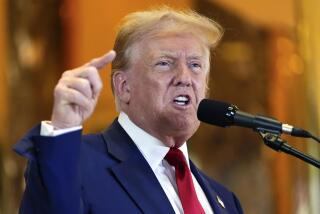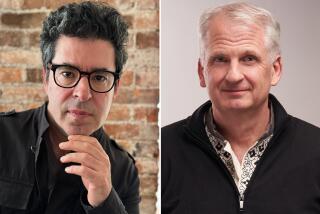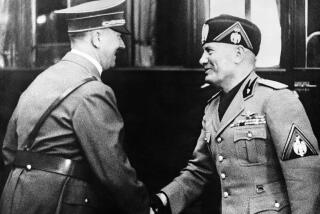Why Mussolini Still Matters
- Share via
A quasi-Chaplinesque image of fascist dictator Benito Mussolini has prevailed since his violent death in April 1945. Postwar biographers of the Italian Duce delivered a succession of body blows to the man’s reputation so severe that his transmogrification from brutal fascist to a “sawdust Caesar” now dominates many popular perceptions of him. Fascist Italy’s mediocre--at best--military performance in World War II, a performance so glaringly out of sync with the dictator’s imperial pretensions, fueled such interpretations of his life. Thus Mussolini became a buffoon and clown, a second-rate sanguinario not in the same league as Hitler and Stalin.
Aside from the fact that such notions of the man and his regime are at best simplistic, this ridicule has invariably generated considerable resentment within Italy. Certainly a challenge to prevailing ideas about Mussolini and fascism was not long in emerging and came, inevitably, from the right of the Italian political spectrum.
While not openly pro-fascist, the work of such prominent scholars as the late Renzo De Felice were certainly far less critical than that of many of their non-Italian counterparts. The De Felice clique erased or played down the less palatable aspects of the fascist era in Italy (domestic repression, colonial brutality, international delinquency and aggressive militarism) and attempted to argue that Mussolini had been no more than a benign autocrat diligently defending Italy from the Bolshevik and even Germanic hordes. In political terms De Felice’s approach has found a ready resonance in the Italy of today, where both the governing coalition’s Alleanza Nazionale component and groups such as the neo-fascist Forza Nuova look to Mussolini as a sort of ideological messiah and insist that De Felice’s multivolume biography is an honest and accurate analysis of his life and politics.
Needless to say the two viewpoints are fiercely and mutually hostile to each other, and will remain so. Anyone, like Australian social historian R.J.B. Bosworth, who treads on this political minefield is a brave individual indeed. Not only do authors who tackle the question of interpreting Mussolini’s ideological outlook face a tricky and controversial intellectual quagmire, but they do so at a time when the politics of the extreme right are again in vogue in continental Europe.
Bosworth’s new assessment of Mussolini emerges at a moment when the belief that social exclusion, this time around founded on the crass idea that immigrants and “asylum seekers” should be forcibly repatriated, has again gained alarming levels of support in mainstream European societies such as France, Holland and, yes, Italy. This makes it critically important to expose the fallacy of such notions, based, effectively, on “purifying” society, last time around.
Bosworth’s overall approach is to chart a middle way between De Felicean apologia and the derision of orthodox Anglo-American academic scholarship. For Bosworth, Italy under il Duce was, and remained, “the least of the Great Powers” and, by implication, Mussolini constituted the lesser evil in a century besmirched by Nazi and Stalinist atrocities. As he argues, Mussolini was “cruel (but not the cruelest),” racist but in an “erratic” and “unscientific” way. Revealing his own background as a social historian of Italy, Bosworth refutes “intentionalist” scholars who argue that Mussolini led from the front. As far as Bosworth’s work is concerned, “to a considerable degree Mussolini did not even dictate” but, on the contrary, had been swept along by “destiny.”
Of course not everyone will agree with Bosworth’s general arguments. For one thing his view that Mussolinian imperialism was “old-fashioned” and “ramshackle,” and therefore very different from National Socialism’s racially driven quest for Lebensraum, is not entirely convincing. Mussolini’s policy during the Libyan war of “reconquest” (1921-31) was violent and repressive in the extreme, being based on the imposition of “fascist” rule in the rebellious Italian colony. Likewise, fascist aggression against Ethiopia (1935-40) was marked by widespread use of mustard gas, mass executions and indiscriminate violence against “racial inferiors,” many of them women and children. More to the point, such barbarity was undertaken by the fascist military on Mussolini’s direct instructions. While there can be no doubting Bosworth’s integrity and his repugnance for such activities, his attempt to quantify the question of inhumanity by claiming that fascist barbarity paled into insignificance alongside Hitler’s “Night of the Long Knives” in June 1934 and the Stalinist purges, relegates Mussolini to a sort of second division for despots. This approach misses the point. The fact is that Mussolini was responsible for the deaths of about 1 million human beings and the suffering of countless others. In addition, in 1939, with the full horror of National Socialist Darwinian-style “social cleansing” already plainly manifest, he signed the Pact of Steel with Hitler and embarked on his long-anticipated European war. Would Mussolini have attempted to restrain the Fuhrer’s murderous racial program had the Rome-Berlin Axis prevailed? Did he attempt to dissuade the Nazi hierarchy from pursuing the persecution of European Jewry? The answer to both questions is no.
This leads neatly into the question of how Bosworth does, ultimately, interpret the nature of Mussolini and fascismo. For the sake of brevity we might look at two of his book’s main themes: the extent to which il Duce conceived of his movement as “totalitarian,” and the revolutionary nature--or otherwise--of Italian foreign policy under his stewardship. Bosworth casts some doubt on Mussolini’s “totalitarian” credentials. He believes that il Duce, a pragmatist, kept his options open and did not automatically select the route to a total state, one in which an institutionalized political religion built around the cult of his personality would replace a tired Roman Catholicism. Mussolini was, Bosworth concludes, too cynical to believe in such solutions. He kept his options open, and even sought a reconciliation with his old socialist friends once in power. This view flies in the face of considerable work, particularly the work of renowned historian Emilio Gentile, which argues to the contrary. Gentile and many others stress that fascism was a revolutionary ideology whose objective was the total annihilation of existing Italian political and social forms and their replacement with new, fascist models. This revolution, by its very nature, would extend into the soul of society, for it was only here that the total conquest of the human spirit was possible. Bosworth is right to conclude that this experiment failed in Italy. But this was not through any lack of conviction on the part of Mussolini. Rather, this failure is best explained by the dictator’s need to temper his revolutionary ardor in order to comply with powerful Italian vested interests (the monarchy, industry, the Vatican), that were more conservative by nature.
Not surprisingly, then, Bosworth also denies any Mussolinian master plan in the field of international politics. He rightly defines the debate on fascist diplomacy as founded on a “contradiction between words and deeds.” In short, Mussolini seemed rich on bombastic war-like rhetoric but short on concrete action. In fairness this argument is more pertinent when applied to the first decade of fascist rule, a period when Mussolini lacked an apogee in the form of Hitler’s Germany. Its explanation is simple. The fascist leader may have, as Bosworth notes, ordered an assault on Yugoslavia in 1926 but this was “not followed up,” as he puts it, simply because the Italian military leadership refused to endorse it given that it would also involve a clash with Belgrade’s main ally, France. Later, with Hitler neatly installed in Berlin, the Italian regime did wage wars (in Ethiopia, Spain and Albania), and prepared for a great Mediterranean confrontation with the Anglo-French empires sometime in 1942 by forging the Axis alignment and bankrupting the national exchequer through military spending. In short, ambition and intent were plainly evident in fascist foreign policy; what was lacking in 1939-40 were completed armaments programs and raw materials.
Bosworth has produced a competent, readable account of il Duce’s life that will undoubtedly contribute to the debate on fascism. Had he exposed the true bleakness, and degeneracy of Mussolini’s revolutionary ideology, Bosworth would perhaps have better shown the errors of treading the same path in the 21st century. We do so at our peril. It is essential that we remember this.


